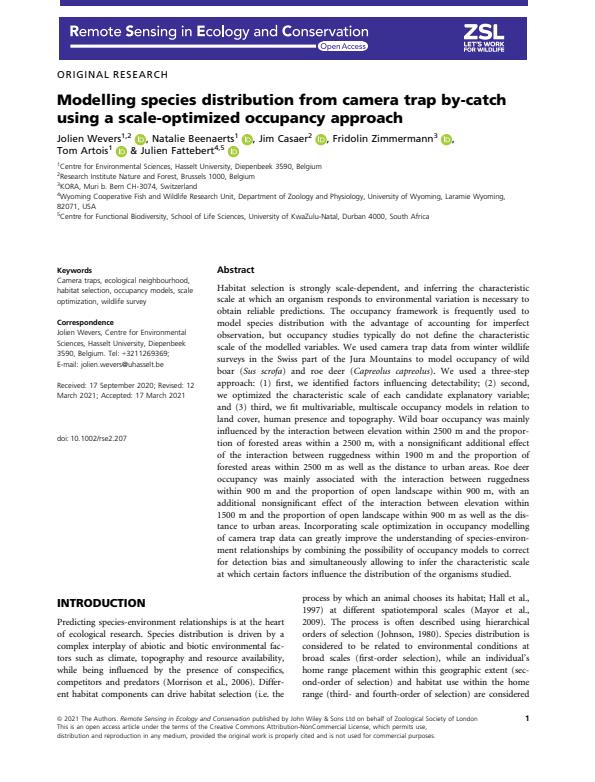Modelling species distribution from camera trap by-catch using a scale-optimized occupancy approach
Details
| Type | A1: Web of Science-artikel |
|---|---|
| Categorie | Onderzoek |
| Tijdschrift | Remote Sensing in Ecology and Conservation |
| Issns | 2056-3485 |
| Uitgeverij | John Wiley & Sons, Ltd |
| Taal | Nederlands |
Bibtex
@misc{baada7cf-8ea4-4498-a0f0-1a13fabd35cd,
title = "Modelling species distribution from camera trap by-catch using a scale-optimized occupancy approach",
abstract = "Abstract Habitat selection is strongly scale-dependent, and inferring the characteristic scale at which an organism responds to environmental variation is necessary to obtain reliable predictions. The occupancy framework is frequently used to model species distribution with the advantage of accounting for imperfect observation, but occupancy studies typically do not define the characteristic scale of the modelled variables. We used camera trap data from winter wildlife surveys in the Swiss part of the Jura Mountains to model occupancy of wild boar (Sus scrofa) and roe deer (Capreolus capreolus). We used a three-step approach: (1) first, we identified factors influencing detectability; (2) second, we optimized the characteristic scale of each candidate explanatory variable; and (3) third, we fit multivariable, multiscale occupancy models in relation to land cover, human presence and topography. Wild boar occupancy was mainly influenced by the interaction between elevation within 2500 m and the proportion of forested areas within a 2500 m, with a nonsignificant additional effect of the interaction between ruggedness within 1900 m and the proportion of forested areas within 2500 m as well as the distance to urban areas. Roe deer occupancy was mainly associated with the interaction between ruggedness within 900 m and the proportion of open landscape within 900 m, with an additional nonsignificant effect of the interaction between elevation within 1500 m and the proportion of open landscape within 900 m as well as the distance to urban areas. Incorporating scale optimization in occupancy modelling of camera trap data can greatly improve the understanding of species-environment relationships by combining the possibility of occupancy models to correct for detection bias and simultaneously allowing to infer the characteristic scale at which certain factors influence the distribution of the organisms studied.",
author = "Jolien WEVERS and Natalie Beenaerts and Jim Casaer and Fridolin Zimmermann and Tom Artois and Julien Fattebert",
year = "2021",
month = mei,
day = "06",
doi = "https://doi.org/10.1002/rse2.207",
language = "Nederlands",
publisher = "John Wiley & Sons, Ltd",
address = "België,
type = "Other"
}

